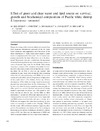Please use this identifier to cite or link to this item:
https://accedacris.ulpgc.es/jspui/handle/10553/877
| DC Field | Value | Language |
|---|---|---|
| dc.contributor.author | Izquierdo, Marisol | en_US |
| dc.contributor.author | Forster, Ian | en_US |
| dc.contributor.author | Divakaran, Subramaniam | en_US |
| dc.contributor.author | Conquest, Lytha | en_US |
| dc.contributor.author | Decamp, O. | en_US |
| dc.contributor.author | Tacon, Albert G. J. | en_US |
| dc.date.accessioned | 2009-10-08T02:31:00Z | - |
| dc.date.accessioned | 2018-03-01T13:42:16Z | - |
| dc.date.available | 2018-03-01T13:42:16Z | - |
| dc.date.issued | 2006 | en_US |
| dc.identifier.isbn | 13535773 | - |
| dc.identifier.issn | 1353-5773 | en_US |
| dc.identifier.other | Hosting | - |
| dc.identifier.other | WoS | - |
| dc.identifier.uri | https://accedacris.ulpgc.es/handle/10553/877 | - |
| dc.description.abstract | Despite the shrimp ability to obtain additional nutrients from food organisms endogenously produced within the green water system has been suggested as one of the causes for the better performance of Pacific white shrimp reared in green water in comparison with clear water, the nutritional components responsible for these effects have yet to be determined. The present study aims to understand the importance of natural food organisms in zero-water exchange systems as source of essential fatty acids for the Pacific white shrimp Litopenaeus vannamei. Five treatments were tested: two conducted in mesocosms systems with shrimp-fed diets containing either fish oil (FO) or olive oil, and another three conducted in clear water with shrimp-fed diets containing either olive oil, a docosahexaenoic acid (DHA)-rich oil or an arachidonic acid (ARA)-rich oil. The presence of higher levels of fatty acids 16:1n-7, 17:1, 20:4n-6, 20:3n-3 and 22:5n-6, characteristic of floc lipids, in shrimp reared in mesocosms denoted their assimilation from the floc. Substitution of FO by olive oil in diets for shrimp reared in mesocosms did not affect growth or survival. Survival and growth of shrimp reared in mesocosms was better than those reared in clear water and fed an olive oil diet, whereas DHA or ARA enrichment of non-fish oil (NFO) diet improved survival of shrimp reared in clear water. Higher survival rate, triglyceride and DHA content in whole body and eyes of shrimp fed a DHA-rich diet suggests that under these conditions, in clear water, it is necessary to include at least 4.8 g kg)1 DHA in diet dry weight. ARA enrichment seemed to negatively affect growth. The nutritional contribution of the floc to shrimp in mesocosm culture reduces or eliminates the need for a dietary source of FO and illustrates the importance of DHA and ARA to enhance shrimp survival in clear water conditions. | en_US |
| dc.language | eng | en_US |
| dc.relation.ispartof | Aquaculture Nutrition | en_US |
| dc.source | Aquaculture Nutrition [ISSN 1353-5773], v. 12, pp. 192-202 | en_US |
| dc.subject | 251092 Acuicultura marina | en_US |
| dc.subject.other | Unsaturated Fatty-Acids | en_US |
| dc.subject.other | Docosahexaenoic Acid | en_US |
| dc.subject.other | Penaeus | en_US |
| dc.subject.other | Prawn | en_US |
| dc.subject.other | Requirements | en_US |
| dc.subject.other | Nutrition | en_US |
| dc.subject.other | Diets | en_US |
| dc.subject.other | Wild | en_US |
| dc.subject.other | Arachidonic Acid | en_US |
| dc.subject.other | Fatty Acids | en_US |
| dc.subject.other | Green Water | en_US |
| dc.subject.other | Mesocosms | en_US |
| dc.subject.other | Pacific White Shrimp | en_US |
| dc.title | Effect of green and clear water and lipid source on survival, growth and biochemical composition of Pacific white shrimp Litopenaeus vannamei | en_US |
| dc.type | info:eu-repo/semantics/article | en_US |
| dc.type | Article | en_US |
| dc.identifier.isi | 000237178500004 | - |
| dc.identifier.absysnet | 349242 | - |
| dc.identifier.crisid | 95;-;-;-;-;- | - |
| dc.identifier.eissn | 1365-2095 | - |
| dc.description.lastpage | 202 | en_US |
| dc.identifier.issue | 3 | - |
| dc.description.firstpage | 192 | en_US |
| dc.relation.volume | 12 | en_US |
| dc.investigacion | Ciencias | en_US |
| dc.rights.accessrights | info:eu-repo/semantics/openAccess | - |
| dc.type2 | Artículo | en_US |
| dc.contributor.daisngid | 31444473 | - |
| dc.contributor.daisngid | 773305 | - |
| dc.contributor.daisngid | 2272625 | - |
| dc.contributor.daisngid | 5234413 | - |
| dc.contributor.daisngid | 1903478 | - |
| dc.contributor.daisngid | 728454 | - |
| dc.identifier.external | 95;-;-;-;-;- | - |
| dc.identifier.external | 95;-;-;-;-;- | - |
| dc.description.numberofpages | 11 | en_US |
| dc.utils.revision | Sí | en_US |
| dc.contributor.wosstandard | WOS:Izquierdo, M | - |
| dc.contributor.wosstandard | WOS:Forster, I | - |
| dc.contributor.wosstandard | WOS:Divakaran, S | - |
| dc.contributor.wosstandard | WOS:Conquest, L | - |
| dc.contributor.wosstandard | WOS:Decamp, O | - |
| dc.contributor.wosstandard | WOS:Tacon, A | - |
| dc.date.coverdate | Junio 2006 | en_US |
| dc.identifier.supplement | 95;-;-;-;-;- | - |
| dc.identifier.ulpgc | Sí | es |
| dc.description.jcr | 1,642 | |
| dc.description.jcrq | Q1 | |
| dc.description.scie | SCIE | |
| item.fulltext | Con texto completo | - |
| item.grantfulltext | open | - |
| crisitem.author.dept | GIR Grupo de Investigación en Acuicultura | - |
| crisitem.author.dept | IU de Investigación en Acuicultura Sostenible y Ec | - |
| crisitem.author.dept | Departamento de Biología | - |
| crisitem.author.orcid | 0000-0003-4297-210X | - |
| crisitem.author.parentorg | IU de Investigación en Acuicultura Sostenible y Ec | - |
| crisitem.author.fullName | Izquierdo López, María Soledad | - |
| Appears in Collections: | Artículos | |
WEB OF SCIENCETM
Citations
74
checked on Feb 25, 2024
Page view(s)
108
checked on Jun 1, 2024
Download(s)
376
checked on Jun 1, 2024
Google ScholarTM
Check
Altmetric
Share
Export metadata
Items in accedaCRIS are protected by copyright, with all rights reserved, unless otherwise indicated.
